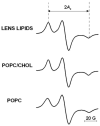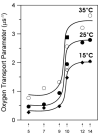Physical properties of the lipid bilayer membrane made of calf lens lipids: EPR spin labeling studies
- PMID: 17451639
- PMCID: PMC2041941
- DOI: 10.1016/j.bbamem.2007.03.007
Physical properties of the lipid bilayer membrane made of calf lens lipids: EPR spin labeling studies
Abstract
The physical properties of a membrane derived from the total lipids of a calf lens were investigated using EPR spin labeling and were compared with the properties of membranes made of an equimolar 1-palmitoyl-2-oleoylphosphatidylcholine/cholesterol (POPC/Chol) mixture and of pure POPC. Conventional EPR spectra and saturation-recovery curves show that spin labels detect a single homogenous environment in all three membranes. Profiles of the order parameter, hydrophobicity, and oxygen transport parameter are practically identical in lens lipid and POPC/Chol membranes, but differ drastically from profiles in pure POPC membranes. In both lens lipid and POPC/Chol membranes, the lipids are strongly immobilized at all depths, which is in contrast to the high fluidity of the POPC membrane. Hydrophobicity and oxygen transport parameter profiles in lens lipid and POPC/Chol membranes have a rectangular shape with an abrupt change between the C9 and C10 positions, which is approximately where the steroid ring structure of cholesterol reaches into the membrane. At this position, hydrophobicity increases from the level of methanol to the level of hexane, and the oxygen transport parameter increases by a factor of 2-3. These profiles in POPC membranes are bell-shaped. It is concluded that the high level of cholesterol in lens lipids makes the membrane stable, immobile, and impermeable to both polar and nonpolar molecules.
Figures










Similar articles
-
Physical properties of the lipid bilayer membrane made of cortical and nuclear bovine lens lipids: EPR spin-labeling studies.Biochim Biophys Acta. 2009 Nov;1788(11):2380-8. doi: 10.1016/j.bbamem.2009.09.005. Epub 2009 Sep 15. Biochim Biophys Acta. 2009. PMID: 19761756 Free PMC article.
-
Oxygen permeability of the lipid bilayer membrane made of calf lens lipids.Biochim Biophys Acta. 2007 Oct;1768(10):2635-45. doi: 10.1016/j.bbamem.2007.06.018. Epub 2007 Jun 29. Biochim Biophys Acta. 2007. PMID: 17662231 Free PMC article.
-
Is the cholesterol bilayer domain a barrier to oxygen transport into the eye lens?Biochim Biophys Acta Biomembr. 2018 Feb;1860(2):434-441. doi: 10.1016/j.bbamem.2017.10.020. Epub 2017 Oct 25. Biochim Biophys Acta Biomembr. 2018. PMID: 29079282 Free PMC article.
-
Cholesterol Bilayer Domains in the Eye Lens Health: A Review.Cell Biochem Biophys. 2017 Dec;75(3-4):387-398. doi: 10.1007/s12013-017-0812-7. Epub 2017 Jun 29. Cell Biochem Biophys. 2017. PMID: 28660427 Free PMC article. Review.
-
Organization of lipids in fiber-cell plasma membranes of the eye lens.Exp Eye Res. 2017 Mar;156:79-86. doi: 10.1016/j.exer.2016.03.004. Epub 2016 Mar 14. Exp Eye Res. 2017. PMID: 26988627 Free PMC article. Review.
Cited by
-
Measuring the viscosity of whole bovine lens using a fiber optic oxygen sensing system.Mol Vis. 2014 Jan 29;20:125-31. eCollection 2014. Mol Vis. 2014. PMID: 24505211 Free PMC article.
-
Characterization of lipid domains in reconstituted porcine lens membranes using EPR spin-labeling approaches.Biochim Biophys Acta. 2008 Apr;1778(4):1079-90. doi: 10.1016/j.bbamem.2008.01.024. Epub 2008 Feb 11. Biochim Biophys Acta. 2008. PMID: 18298944 Free PMC article.
-
Physical properties of the lipid bilayer membrane made of cortical and nuclear bovine lens lipids: EPR spin-labeling studies.Biochim Biophys Acta. 2009 Nov;1788(11):2380-8. doi: 10.1016/j.bbamem.2009.09.005. Epub 2009 Sep 15. Biochim Biophys Acta. 2009. PMID: 19761756 Free PMC article.
-
A 13 C-Labeled Triarylmethyl Radical as an EPR Spin Probe Highly Sensitive to Molecular Tumbling.Angew Chem Int Ed Engl. 2020 Sep 14;59(38):16451-16454. doi: 10.1002/anie.202006591. Epub 2020 Jul 21. Angew Chem Int Ed Engl. 2020. PMID: 32542924 Free PMC article.
-
Membrane Partitioning of TEMPO Discriminates Human Lung Cancer from Neighboring Normal Cells.Acta Naturae. 2023 Oct-Dec;15(4):111-120. doi: 10.32607/actanaturae.19426. Acta Naturae. 2023. PMID: 38234602 Free PMC article.
References
-
- Rafferty NS. Lens morphology. In: Maisel H, editor. The Ocular Lens: Structure, Function and Pathology. Marcel Dekker; New York: 1985. pp. 1–60.
-
- Li LK, So L, Spector A. Membrane cholesterol and phospholipids in consecutive concentric sections of human lenses. J Lipid Res. 1985;26:600–609. - PubMed
-
- Li LK, So L, Spector A. Age-dependent changes in the distribution and concentration of human lens cholesterol and phospholipids. Biochim Biophys Acta. 1987;917:112–120. - PubMed
-
- Truscott R. Age-related nuclear cataract: a lens transport problem. Ophthalmic Res. 2000;32:185–194. - PubMed
-
- Byrdwell WC, Borchman D, Porter RA, Taylor KG, Yappert MC. Separation and characterization of the unknown phospholipids in human lens membranes. Invest Ophthalmol Vis Sci. 1994;35:4333–4343. - PubMed
Publication types
MeSH terms
Substances
Grants and funding
LinkOut - more resources
Full Text Sources
Other Literature Sources
Research Materials
Miscellaneous

